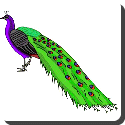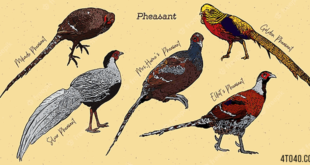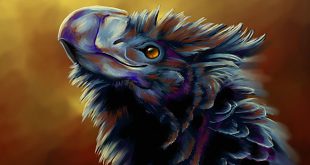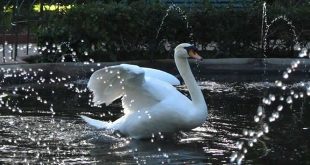 Peacock — Peafowl are two asiatic species of flying birds in the genus Pavo of the pheasant family, Phasianidae, best known for the male’s extravagant eye-spotted tail, which it displays as part of courtship. The male is called a peacock, the female a peahen, and the offspring peachicks. The adult female peafowl is grey and/or brown. Peachicks can be between yellow and a tawny colour with darker brown patches.
Peacock — Peafowl are two asiatic species of flying birds in the genus Pavo of the pheasant family, Phasianidae, best known for the male’s extravagant eye-spotted tail, which it displays as part of courtship. The male is called a peacock, the female a peahen, and the offspring peachicks. The adult female peafowl is grey and/or brown. Peachicks can be between yellow and a tawny colour with darker brown patches.
The species are:
- Indian Peafowl, Pavo cristatus, a resident breeder in South Asia. The peacock is designated as the national bird of India and the provincial bird of Punjab.
- Green Peafowl, Pavo muticus. Breeds from Burma east to Java. The IUCN lists the Green Peafowl as vulnerable to extinction due to hunting and a reduction in extent and quality of habitat.
The male (peacock) Indian Peafowl has iridescent blue-green or green coloured plumage. The peacock tail (“train”) is not the tail quill feathers but the highly elongated upper tail coverts. The “eyes” are best seen when the peacock fans its tail. Like a cupped hand behind the ear the erect tail-fan of the male helps direct sound to the ears. Both species have a crest atop the head. The female (peahen) Indian Peafowl has a mixture of dull green, brown, and grey in her plumage. She lacks the long upper tail coverts of the male but has a crest. The female can also display her plumage to ward off female competition or signal danger to her young.
The Green Peafowl appears different from the Indian Peafowl. The male has green and gold plumage and has an erect crest. The wings are black with a sheen of blue. Unlike the Indian Peafowl, the Green Peahen is similar to the male, only having shorter upper tail coverts and less iridescence. It is difficult to tell a juvenile male from an adult female.
As with many birds, vibrant plumage colours are not primarily pigments, but optical interference Bragg reflections, based on regular, periodic nanostructures of the barbules (fiber-like components) of the feathers. Slight changes to the spacing result in different colours. Brown feathers are a mixture of red and blue: one colour is created by the periodic structure, and the other is a created by a Fabry–Pérot interference peak from reflections from the outer and inner boundaries. Such interference-based structural colour is important for the peacock’s iridescent hues that change and shimmer with viewing angle, since unlike pigments, interference effects depend on light angle.
Colour mutations exist through selective breeding, such as the leucistic White Peafowl and the Black-Shouldered Peafowl.
The peafowl are forest birds that nest on the ground but roost in trees. They are terrestrial feeders.
Both species of Peafowl are believed to be polygamous. However, it has been suggested that “females” entering a male Green Peafowl’s territory are really his own juvenile or sub-adult young (K. B. Woods in lit. 2000) and that Green Peafowl are really monogamous in the wild. The male peacock flares out his feathers when he is trying to get the female’s attention.
During the mating season they will often emit a very loud high-pitched cry. They also travel in hunting packs between ten and ninety.
Peafowl are omnivorous and eat most plant parts, flower petals, seed heads, insects and other arthropods, reptiles, and amphibians.
In common with other members of the Galliformes, males possess metatarsal spurs or “thorns” used primarily during intraspecific fights.
Peafowl have left captivity and developed permanent, free-roaming populations in India, Japan, and England. There are permanent feral populations in Metropolitan South Florida that are protected by law. Musters of peafowl are frequently seen in the Coconut Grove area of Miami and near Biscayne Bay in the municipalities of Palmetto Bay and Cutler Bay. They have been a source of controversy in Miami-Dade County for years. These peafowl may be descendents of birds dispersed by Hurricane Andrew from the Wings of Asia aviary at the Miami Dade Zoological Park and Gardens in 1992.
In Hinduism, the Peacock is associated with Saraswati, a deity representing benevolence, patience, kindness, compassion and knowledge. Peacock is also the mount of Hindu God of war Murugan. The peacock is the steed of Kartikay, the brother of Ganesha. Similar to Saraswati, the Peacock is associated with Kwan-yin in Asian spirituality. Kwan-yin (or Quan Yin) is also an emblem of love, compassionate watchfulness, good-will, nurturing, and kind-heartedness. Legend tells us she chose to remain a mortal even though she could be immortal because she wished to stay behind and aid humanity in their spiritual evolution.
 Kids Portal For Parents India Kids Network
Kids Portal For Parents India Kids Network




